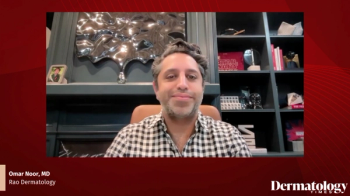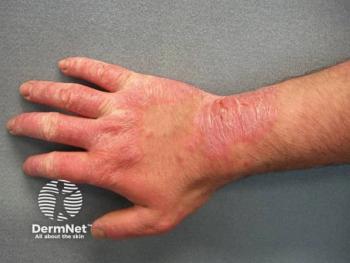
Reviewing the Multifactorial Nature of Chronic Hand Eczema and Upcoming Delgocitinib
Key Takeaways
- Chronic hand eczema is distinct from atopic dermatitis, requiring accurate diagnosis and targeted therapy for effective management.
- Current AD therapies may not address all mechanisms of CHE, highlighting the need for specific treatments such as delgocitinib.
At the 2025 Revolutionizing Atopic Dermatitis Conference, JiaDe “Jeff” Yu, MD, MS, discussed the multifactorial nature of chronic hand eczema, highlighting its distinction from atopic dermatitis.
“The treatment for chronic hand eczema really depends on what we are trying to treat. If it's AD [atopic dermatitis], I think a lot of the present AD therapies are very effective for it, especially the ones that are targeting particular pathways. However, if we're not treating AD in chronic hand eczema, and a lot of chronic hand eczema is not AD, we may actually be failing the patient. That's where some of these more newer therapies really come in handy,” said JiaDe “Jeff” Yu, MD, MS, in an interview with Dermatology Times.
Yu, assistant professor of dermatology at Harvard Medical School and the director of the Occupational and Contact Dermatitis Clinic at Massachusetts General Hospital in Boston, presented updates on chronic hand eczema (CHE) at the
Yu first discussed that although CHE is often associated with or mistaken for AD, CHE is a distinct, multifactorial condition that encompasses a range of barrier-disruptive dermatoses. These include irritant contact dermatitis, allergic contact dermatitis, AD, and other eczematous processes, making accurate diagnosis and targeted therapy essential.2
Highlighting the burden of disease, Yu explained the occupational and psychosocial impact of CHE. Yu noted that current treatment for CHE often involves repurposing existing AD therapies. Although JAK inhibitors and non-steroidal topicals have demonstrated efficacy for the AD component of CHE, they may be less effective when CHE is driven by other mechanisms.
“We think about it as hand eczema, but probably it's the most critical part of your body when you're really trying to interact with the community. Whether it’s with work, whether it's with a loved one, or whether it's with your child, hand eczema affects all of us,” he said.
Among the most anticipated developments in CHE management is delgocitinib, a topical pan-JAK inhibitor that may become the first FDA-approved therapy specifically for CHE. In a comparative study against oral alitretinoin—a standard-of-care treatment in Canada and Europe but unavailable in the US—delgocitinib demonstrated comparable efficacy with a favorable safety profile. Yu highlighted the significance of a well-tolerated topical agent that directly targets the inflammatory pathways central to CHE.
In his clinical practice, Yu also sees patients with allergic contact dermatitis (ACD), for which no pharmacologic treatments exist beyond allergen avoidance. He called for collaboration with industry to develop targeted therapies for ACD, particularly for patients who cannot eliminate allergen exposures due to occupational or lifestyle factors.
Yu praised the RAD conference for its focused, high-level exchange of ideas among clinicians, researchers, and industry leaders. “With disease-specific meetings like this, you come in knowing some, you leave knowing a lot,” he concluded.
References
- Yu J, Drew SG. Chronic hand eczema. Presented at: 2025 Revolutionizing Atopic Dermatitis Conference; June 6-7, 2025; Nashville, TN
- Noor O. Understanding chronic hand eczema: cellular mechanisms and therapeutic implications. Dermatology Times. April 23, 2025. Accessed June 8, 2025.
https://www.dermatologytimes.com/view/understanding-chronic-hand-eczema-cellular-mechanisms-and-therapeutic-implications
Newsletter
Like what you’re reading? Subscribe to Dermatology Times for weekly updates on therapies, innovations, and real-world practice tips.



















